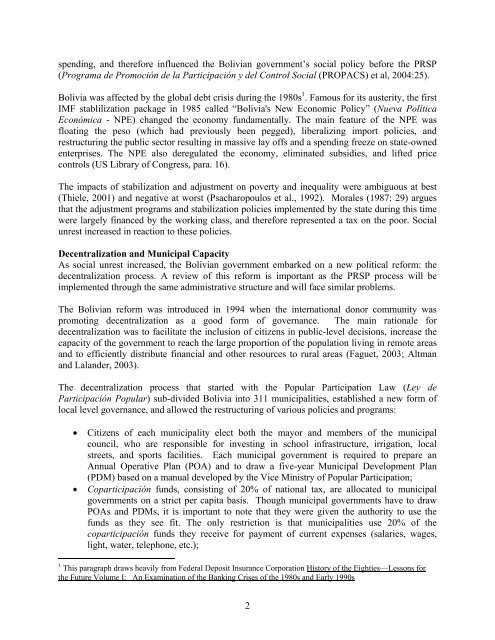Assessing the impact of PRSPs on Child Poverty: The Case of Bolivia
Assessing the impact of PRSPs on Child Poverty: The Case of Bolivia
Assessing the impact of PRSPs on Child Poverty: The Case of Bolivia
You also want an ePaper? Increase the reach of your titles
YUMPU automatically turns print PDFs into web optimized ePapers that Google loves.
spending, and <str<strong>on</strong>g>the</str<strong>on</strong>g>refore influenced <str<strong>on</strong>g>the</str<strong>on</strong>g> <strong>Bolivia</strong>n government’s social policy before <str<strong>on</strong>g>the</str<strong>on</strong>g> PRSP<br />
(Programa de Promoción de la Participación y del C<strong>on</strong>trol Social (PROPACS) et al, 2004:25).<br />
<strong>Bolivia</strong> was affected by <str<strong>on</strong>g>the</str<strong>on</strong>g> global debt crisis during <str<strong>on</strong>g>the</str<strong>on</strong>g> 1980s 1 . Famous for its austerity, <str<strong>on</strong>g>the</str<strong>on</strong>g> first<br />
IMF stablilizati<strong>on</strong> package in 1985 called “<strong>Bolivia</strong>'s New Ec<strong>on</strong>omic Policy” (Nueva Política<br />
Ec<strong>on</strong>ómica - NPE) changed <str<strong>on</strong>g>the</str<strong>on</strong>g> ec<strong>on</strong>omy fundamentally. <strong>The</strong> main feature <str<strong>on</strong>g>of</str<strong>on</strong>g> <str<strong>on</strong>g>the</str<strong>on</strong>g> NPE was<br />
floating <str<strong>on</strong>g>the</str<strong>on</strong>g> peso (which had previously been pegged), liberalizing import policies, and<br />
restructuring <str<strong>on</strong>g>the</str<strong>on</strong>g> public sector resulting in massive lay <str<strong>on</strong>g>of</str<strong>on</strong>g>fs and a spending freeze <strong>on</strong> state-owned<br />
enterprises. <strong>The</strong> NPE also deregulated <str<strong>on</strong>g>the</str<strong>on</strong>g> ec<strong>on</strong>omy, eliminated subsidies, and lifted price<br />
c<strong>on</strong>trols (US Library <str<strong>on</strong>g>of</str<strong>on</strong>g> C<strong>on</strong>gress, para. 16).<br />
<strong>The</strong> <str<strong>on</strong>g>impact</str<strong>on</strong>g>s <str<strong>on</strong>g>of</str<strong>on</strong>g> stabilizati<strong>on</strong> and adjustment <strong>on</strong> poverty and inequality were ambiguous at best<br />
(Thiele, 2001) and negative at worst (Psacharopoulos et al., 1992). Morales (1987: 29) argues<br />
that <str<strong>on</strong>g>the</str<strong>on</strong>g> adjustment programs and stabilizati<strong>on</strong> policies implemented by <str<strong>on</strong>g>the</str<strong>on</strong>g> state during this time<br />
were largely financed by <str<strong>on</strong>g>the</str<strong>on</strong>g> working class, and <str<strong>on</strong>g>the</str<strong>on</strong>g>refore represented a tax <strong>on</strong> <str<strong>on</strong>g>the</str<strong>on</strong>g> poor. Social<br />
unrest increased in reacti<strong>on</strong> to <str<strong>on</strong>g>the</str<strong>on</strong>g>se policies.<br />
Decentralizati<strong>on</strong> and Municipal Capacity<br />
As social unrest increased, <str<strong>on</strong>g>the</str<strong>on</strong>g> <strong>Bolivia</strong>n government embarked <strong>on</strong> a new political reform: <str<strong>on</strong>g>the</str<strong>on</strong>g><br />
decentralizati<strong>on</strong> process. A review <str<strong>on</strong>g>of</str<strong>on</strong>g> this reform is important as <str<strong>on</strong>g>the</str<strong>on</strong>g> PRSP process will be<br />
implemented through <str<strong>on</strong>g>the</str<strong>on</strong>g> same administrative structure and will face similar problems.<br />
<strong>The</strong> <strong>Bolivia</strong>n reform was introduced in 1994 when <str<strong>on</strong>g>the</str<strong>on</strong>g> internati<strong>on</strong>al d<strong>on</strong>or community was<br />
promoting decentralizati<strong>on</strong> as a good form <str<strong>on</strong>g>of</str<strong>on</strong>g> governance. <strong>The</strong> main rati<strong>on</strong>ale for<br />
decentralizati<strong>on</strong> was to facilitate <str<strong>on</strong>g>the</str<strong>on</strong>g> inclusi<strong>on</strong> <str<strong>on</strong>g>of</str<strong>on</strong>g> citizens in public-level decisi<strong>on</strong>s, increase <str<strong>on</strong>g>the</str<strong>on</strong>g><br />
capacity <str<strong>on</strong>g>of</str<strong>on</strong>g> <str<strong>on</strong>g>the</str<strong>on</strong>g> government to reach <str<strong>on</strong>g>the</str<strong>on</strong>g> large proporti<strong>on</strong> <str<strong>on</strong>g>of</str<strong>on</strong>g> <str<strong>on</strong>g>the</str<strong>on</strong>g> populati<strong>on</strong> living in remote areas<br />
and to efficiently distribute financial and o<str<strong>on</strong>g>the</str<strong>on</strong>g>r resources to rural areas (Faguet, 2003; Altman<br />
and Lalander, 2003).<br />
<strong>The</strong> decentralizati<strong>on</strong> process that started with <str<strong>on</strong>g>the</str<strong>on</strong>g> Popular Participati<strong>on</strong> Law (Ley de<br />
Participación Popular) sub-divided <strong>Bolivia</strong> into 311 municipalities, established a new form <str<strong>on</strong>g>of</str<strong>on</strong>g><br />
local level governance, and allowed <str<strong>on</strong>g>the</str<strong>on</strong>g> restructuring <str<strong>on</strong>g>of</str<strong>on</strong>g> various policies and programs:<br />
• Citizens <str<strong>on</strong>g>of</str<strong>on</strong>g> each municipality elect both <str<strong>on</strong>g>the</str<strong>on</strong>g> mayor and members <str<strong>on</strong>g>of</str<strong>on</strong>g> <str<strong>on</strong>g>the</str<strong>on</strong>g> municipal<br />
council, who are resp<strong>on</strong>sible for investing in school infrastructure, irrigati<strong>on</strong>, local<br />
streets, and sports facilities. Each municipal government is required to prepare an<br />
Annual Operative Plan (POA) and to draw a five-year Municipal Development Plan<br />
(PDM) based <strong>on</strong> a manual developed by <str<strong>on</strong>g>the</str<strong>on</strong>g> Vice Ministry <str<strong>on</strong>g>of</str<strong>on</strong>g> Popular Participati<strong>on</strong>;<br />
• Coparticipación funds, c<strong>on</strong>sisting <str<strong>on</strong>g>of</str<strong>on</strong>g> 20% <str<strong>on</strong>g>of</str<strong>on</strong>g> nati<strong>on</strong>al tax, are allocated to municipal<br />
governments <strong>on</strong> a strict per capita basis. Though municipal governments have to draw<br />
POAs and PDMs, it is important to note that <str<strong>on</strong>g>the</str<strong>on</strong>g>y were given <str<strong>on</strong>g>the</str<strong>on</strong>g> authority to use <str<strong>on</strong>g>the</str<strong>on</strong>g><br />
funds as <str<strong>on</strong>g>the</str<strong>on</strong>g>y see fit. <strong>The</strong> <strong>on</strong>ly restricti<strong>on</strong> is that municipalities use 20% <str<strong>on</strong>g>of</str<strong>on</strong>g> <str<strong>on</strong>g>the</str<strong>on</strong>g><br />
coparticipación funds <str<strong>on</strong>g>the</str<strong>on</strong>g>y receive for payment <str<strong>on</strong>g>of</str<strong>on</strong>g> current expenses (salaries, wages,<br />
light, water, teleph<strong>on</strong>e, etc.);<br />
1 This paragraph draws heavily from Federal Deposit Insurance Corporati<strong>on</strong> History <str<strong>on</strong>g>of</str<strong>on</strong>g> <str<strong>on</strong>g>the</str<strong>on</strong>g> Eighties—Less<strong>on</strong>s for<br />
<str<strong>on</strong>g>the</str<strong>on</strong>g> Future Volume I: An Examinati<strong>on</strong> <str<strong>on</strong>g>of</str<strong>on</strong>g> <str<strong>on</strong>g>the</str<strong>on</strong>g> Banking Crises <str<strong>on</strong>g>of</str<strong>on</strong>g> <str<strong>on</strong>g>the</str<strong>on</strong>g> 1980s and Early 1990s<br />
2



